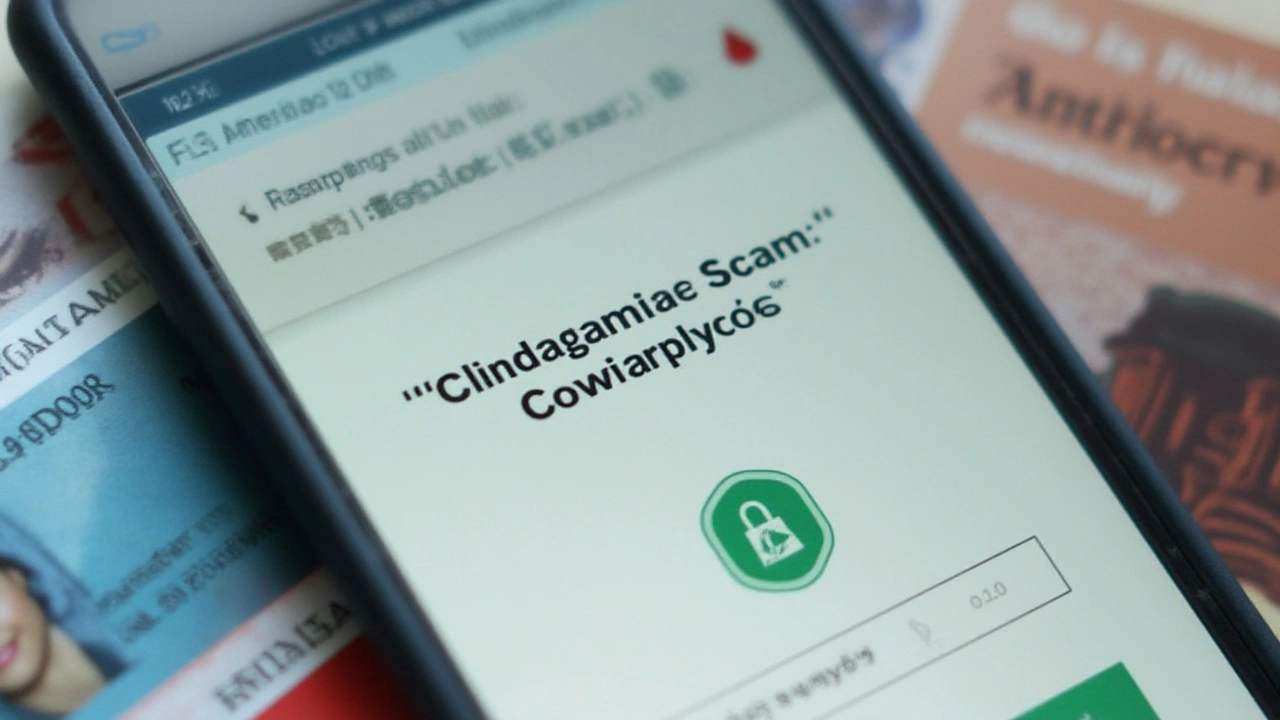
Picture this: you wake up with an annoying, burning pain under your skin. Your doctor has diagnosed it as a bacterial infection and gives you a prescription for Clindamycin. But now that pharmacies are mostly digital—and even regular meds cost an arm and a leg—you're weighing up buying Clindamycin online. But is it safe? Will you get the real deal, or just a pretty-looking bottle of sugar pills? Those are the sorts of questions millions are asking every month in 2025. Internet supplies, e-pharmacies, overnight shipping—buying antibiotics online is both wildly convenient and uncomfortably risky if you don’t know what you’re doing. Here’s what every modern health sleuth should know to buy Clindamycin online smartly and within the law.
What is Clindamycin and Why Do People Buy It Online?
Clindamycin isn’t exactly a household name, but you’d be surprised by how common it is on doctors’ pads. It's an antibiotic that tackles some of the nastiest bacterial infections—stuff like skin infections, pneumonia, bone and joint issues, and even dental abscesses. Dermatologists often prescribe it for stubborn acne. In 2024 alone, over 35 million Clindamycin prescriptions were written in the US, according to the CDC’s openly available drug use dashboard. It’s used in hospitals all the time, especially when other antibiotics don’t work or allergies rule out options like penicillin.
So why do people bother hunting it down online? Sometimes, local pharmacies have weird shortages. Sometimes, it’s just about convenience or privacy—nobody wants to discuss skin infections face-to-face if they can avoid it. In other cases, Clindamycin just isn’t available close by, or the drug costs twice as much due to insurance issues. And then there are people who want it as a back-up (though honestly, self-medicating with antibiotics is never a good idea). With stats showing online pharmacies grow their user base by 24% year-on-year, it’s clear the trend isn’t fading anytime soon.
But there’s also a darker side: the internet is crawling with fake drug sellers. A well-known analysis from LegitScript found that over 85% of websites selling "prescription" drugs in 2023 weren’t operating legally or safely. That’s enough to make anyone gulp. Getting real, safe Clindamycin takes more than a quick Google search. You'll want to know exactly what to look for, and how not to get fleeced.
How to Tell a Trustworthy Online Pharmacy From a Scam
This is where things get real. Not every online pharmacy is a haven for good deals and speedy shipping. In fact, a scary number have no idea where their medicines come from, let alone if they're safe. So, how do you spot a legit operation in 2025?
- Prescription Required: Reputable sites require your doctor's prescription. If a pharmacy says "no prescription needed," that's a red flag. Legitimate pharmacies must follow this basic rule—no dancing around it.
- Verified Pharmacy Accreditation: Trust sites that carry digital badges from recognized verification programs. In the US, look for the NABP’s Digital Pharmacy badge or the FDA’s .pharmacy domain—these aren’t just window dressing, they’re proof a real board approves of their practices.
- Licensed Pharmacists Listed: The pharmacy should have actual pharmacists available for questions and should list a physical address you can recognize as legitimate (though online-only operations may just provide a headquarters—do a quick web search to be sure the address isn’t just a mailbox).
- Safe Payment Options: Site checkout should be HTTPS secured (watch for the lock icon in your browser). Never trust sites asking for wire transfers, crypto, or gift cards as payment for serious medications.
- Unrealistically Low Prices: Sure, everyone wants to save a buck, but if Clindamycin is being sold for a few bucks when pharmacies nationwide charge $25–$50, the pills are likely to be fake, diluted, or simply unsafe. It’s a classic "you get what you pay for" situation.
- Customer Service: Reliable pharmacies offer clear customer support—phone, chat, or at least responsive email. Test it out by asking questions about your Clindamycin prescription—if the response is evasive, generic, or seems like stock copy-paste, run the other way.
Back in 2022, a study in JAMA Network Open reviewed a hundred online pharmacies and found that nearly one in three had no safety checks or pharmacist support. That’s why you really need to do your homework when choosing where to buy.

The Step-By-Step Guide to Buying Clindamycin Online
Ordering antibiotics on the web shouldn’t feel like navigating a maze. But with so much detail at stake, a step-by-step checklist helps. Here’s how to do it safely and sensibly:
- Get a Valid Prescription: This is the foundation. Even if a site says you don’t need one, don’t skip this step. Your health, especially with antibiotics, should not involve guesswork. A doctor’s input ensures Clindamycin is right for your infection, that you’re not allergic, and that you’re getting the right dose.
- Find an Accredited Online Pharmacy: Use resources like the National Association of Boards of Pharmacy’s Safe.Pharmacy tool, or check the FDA’s own pharmacy checker. If you’re outside the US, most countries have government or regulatory body lists of licensed online drug sellers.
- Create an Account and Upload Prescriptions: Most legit sites will have a secure, step-by-step process for this. You’ll need to scan and upload your prescription. Some will ask for your doctor’s contact for verification (a good sign).
- Double-Check the Medication Details: Before placing your order, confirm the form and dosage your doctor prescribed. Some websites list Clindamycin as capsules and as topical gels—don’t mix them up. Read all info sheets and packaging instructions on the pharmacy’s page.
- Review Payment Methods: Stick with trusted options (credit cards, secure e-wallets). Avoid any site pushing direct transfers or anonymous payments.
- Track Your Order: Reliable pharmacies provide tracking for your shipment. When your Clindamycin arrives, inspect the packaging and seals. There should be an expiry date and detailed label. If the packet looks odd or is missing any safety markings, don’t take the risk—contact customer support right away and double-check the pills’ imprint using sites like Pillbox or Drugs.com’s identifier tools.
- Store and Use Properly: Store the medication as the label advises. Never share antibiotics with others or save leftovers for later. This helps avoid resistance and keeps you (and others) healthier in the long run.
Here’s a useful table with some fast facts and figures about online Clindamycin:
| Detail | Key Info (2025) |
|---|---|
| Average Online Price (US) | $25–$65 for 20 capsules (150mg) |
| Number of Fake Pharmacy Sites | Estimated 35,000 globally |
| Top Online Pharmacy Verifier (US) | Safe.Pharmacy (NABP) |
| Prescription Required | Yes, always |
| Shipping Time (express) | 1–3 days in most metro areas |
| Common Formulations | Capsule, injection, topical gel |
If anything seems off during your order—or if your symptoms aren’t improving while taking Clindamycin—don’t play doctor. Get a professional opinion, fast. Most legitimate pharmacies are happy to answer follow-ups and questions, especially those related to side effects or missed doses.
What Laws and Regulations Shape Buying Clindamycin Online?
This question trips up a ton of first-time buyers. You might think: if a website sells it, they must be allowed to, right? Not even close. Every country—and often, every US state—has its own tangle of laws about prescribing and shipping antibiotics online.
In the United States, the FDA sets the rules. Selling Clindamycin without a prescription violates federal law. The same goes for shipping prescription meds across state lines without following detailed transport guidelines—pharmacy sites must have a proper license for every area they serve. A quick lookup of FDA enforcement reports shows thousands of shipments seized each year for noncompliance.
Across the pond in the UK, the General Pharmaceutical Council holds similar standards, and ordering from non-registered online sites (especially out-of-country ones) can mean hefty fines. In Canada, Health Canada oversees online pharmacies and works with the Canadian International Pharmacy Association to help consumers spot fraudsters. Australia and EU nations have similar processes, backed by special “.pharmacy” top-level domains and digital badges.
Is it ever legal to import Clindamycin from an overseas pharmacy to your home country? Sometimes, but rarely—usually, just for small, personal amounts, with a valid prescription, and only from recognized pharmacies. Customs officers can (and do) seize shipments if they look fishy. Some buyers have found themselves on government watchlists just for trying to dodge the system. Always check your country’s drug import rules before hitting “order.”
Then there are privacy and data protection laws: Any pharmacy that collects your health info online must abide by regulations like HIPAA (US), GDPR (Europe), or their local equivalents, safeguarding your prescription and personal information. If a website looks shady with your data, step away—it may not only be risky to your health, but to your identity as well.

Top Tips to Stay Safe and Informed When Buying Clindamycin Online
There’s no substitute for doing your homework. But it doesn’t have to feel like a research project either. Here’s what the savviest buyers do to protect their health, money, and sanity online:
- Always Cross-Check the Pharmacy’s Name: Don’t just trust the first result on Google. Double-check the pharmacy’s name on NABP or your own country’s registry before entering your details.
- Compare Dosages and Packaging: Only buy the specific dosage and form your doctor prescribed. For Clindamycin, the 150mg and 300mg capsules are most common. Watch out for sites pushing “bulk discounts” or unfamiliar brands without past reputation.
- Read Real Customer Reviews: Forums like Reddit’s r/AskDocs or Trustpilot can give clues to a pharmacy’s reliability—just beware of fake or overly glowing reviews. The best ones mention customer service, shipping speed, and packaging details.
- Know the Side Effects: Taking Clindamycin can come with stomach upset, diarrhea, even rare but serious issues like C. difficile infection. Read up before you start, and don’t ignore unusual symptoms.
- Stay Alert for Recalls and Warnings: The FDA regularly updates lists of recalled meds. It’s worth signing up for alerts or checking their searchable lists, just in case a batch of Clindamycin has issues.
- Don’t Share or Hoard Antibiotics: Even if you “have a little left over,” don’t pass it to friends or family. Using antibiotics when you don’t need them helps create drug-resistant bacteria—a problem the WHO ranks as one of the world’s top 10 health threats.
- Dispose Responsibly: Got expired or unused Clindamycin? Many pharmacies now have drop-off points or mail-back programs for safe disposal. Never flush antibiotics or toss them in the trash, as they can end up leaching into water supplies.
If you stick to these basics, you’ll avoid most pitfalls, get genuine medication, and keep your health (and wallet) right where they belong. The digital world can be a goldmine for convenience—but only if you shop smart, stay alert, and use resources built for real people, not just big business.




13 Comments
lol i just ordered clindamycin from a site that looked like it was designed in 2007. got it in 2 days. no prescription. no regrets. 🤡💊
You people are terrifying. Buying antibiotics off a random website is not "convenient"-it’s a public health hazard wrapped in a TikTok trend. If you can’t be bothered to see a doctor, don’t expect the system to bail you out with a PayPal link and a prayer.
It is imperative to underscore that the procurement of prescription pharmaceuticals via unaccredited digital intermediaries constitutes a violation of federal statutory provisions under the Federal Food, Drug, and Cosmetic Act. One must exercise due diligence in verifying licensure through the National Association of Boards of Pharmacy.
I get it-you’re broke, your insurance sucks, and your skin is on fire. But here’s the thing: the internet is a jungle, and half the animals are wearing lab coats. I’ve bought from legit .pharmacy sites before. They’re quiet, they ask for your doc’s info, and they don’t sound like a scammy Shopify store run by a guy named ‘Dr. Cashflow’. Don’t be the person who gets C. diff because you wanted to save $15.
i just found this site called medhub dot com and it was so easy!! like 20 min and my clindamycin was on its way!! i didnt even need a prescrption lol but the packaging looked legit??
America’s healthcare system is a joke. If you’re buying antibiotics online, you’re not stupid-you’re surviving. The real criminals are the pharmaceutical CEOs and insurance brokers who price gouge while you’re lying on your bathroom floor with a fever.
I lost my job last year and my insurance dropped. I had to choose between rent and antibiotics. I chose to live. So don’t you dare judge me for clicking "buy now" on a site that didn’t ask for my social. You have no idea what I’ve been through.
The paradox of modern medicine is that the more we digitize access, the more we fracture trust. We have the infrastructure to deliver life-saving drugs with precision, yet we rely on algorithms and desperation to bridge the gap. The real issue isn’t online pharmacies-it’s the systemic abandonment of healthcare as a right. The pills are just the symptom. The disease is the profit motive.
The data presented in this article is statistically sound, yet the tone is dangerously permissive. The normalization of non-prescription antibiotic acquisition, even under the guise of "convenience," represents a catastrophic erosion of antimicrobial stewardship protocols. This is not a lifestyle choice-it is a biosecurity failure.
If you're considering buying online, start with Safe.Pharmacy. It’s free, it’s legit, and it takes two minutes. I’ve helped three friends find real pharmacies after they got scared by sketchy sites. You don’t have to risk your health to save money. There’s a better way.
i just googled "buy clindamycin online" and picked the first one that looked nice. it worked. i’m fine.
You’re not a patient. You’re a liability. Stop endangering everyone with antibiotic misuse. Go to a clinic. Pay the $40. It’s not that hard.
I live in India and we have a lot of good online pharmacies here that are regulated by CDSCO. I bought my clindamycin from one last month-prescription uploaded, tracking number, real pharmacist chat. It’s possible if you know where to look. Don’t fear tech-just use it wisely.